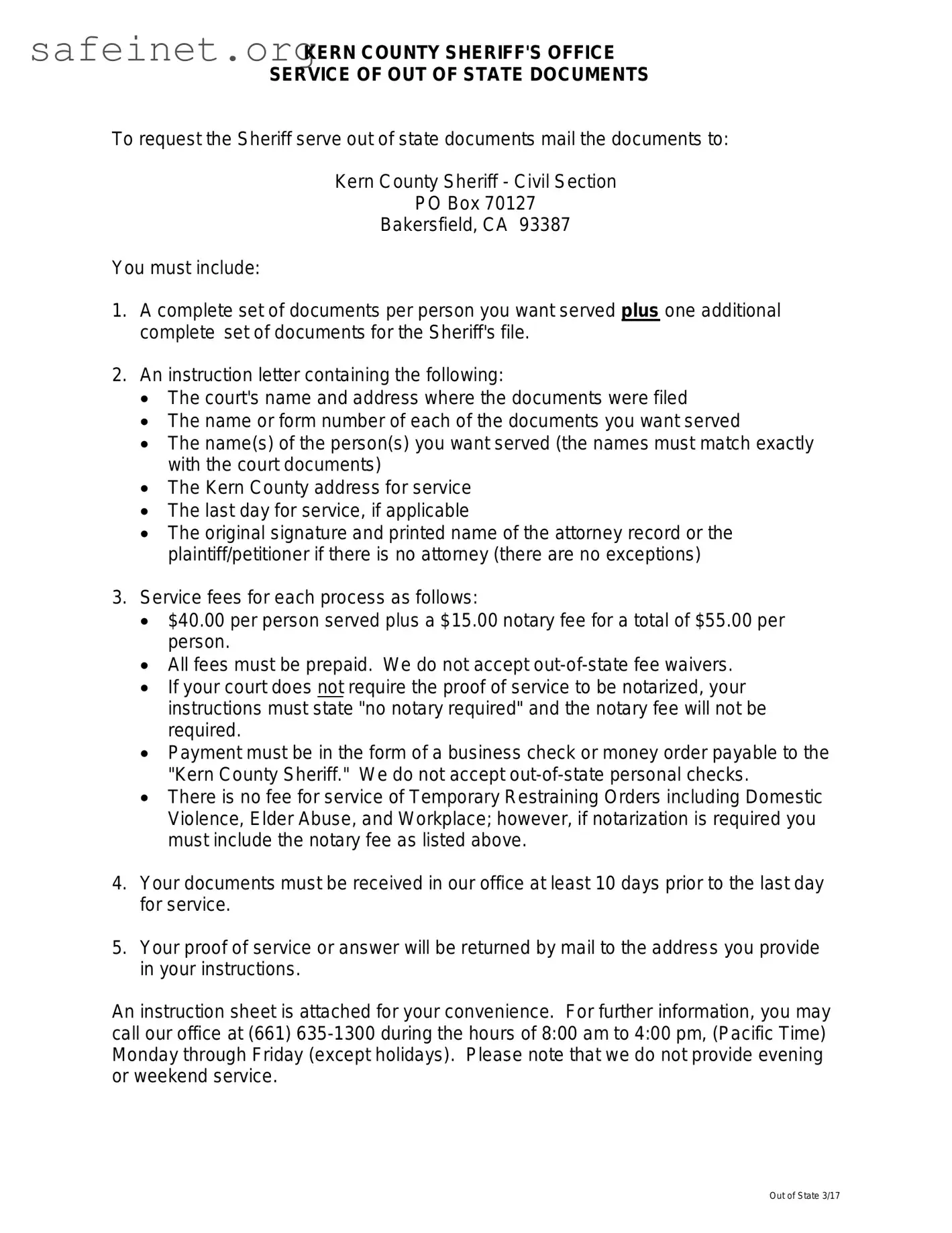KERN COUNTY SHERIFF'S OFFICE
SERVICE OF OUT OF STATE DOCUMENTS
To request the Sheriff serve out of state documents mail the documents to:
Kern County Sheriff - Civil Section
PO Box 70127
Bakersfield, CA 93387
You must include:
1.A complete set of documents per person you want served plus one additional complete set of documents for the Sheriff's file.
2.An instruction letter containing the following:
The court's name and address where the documents were filed
The name or form number of each of the documents you want served
The name(s) of the person(s) you want served (the names must match exactly with the court documents)
The Kern County address for service
The last day for service, if applicable
The original signature and printed name of the attorney record or the plaintiff/petitioner if there is no attorney (there are no exceptions)
3.Service fees for each process as follows:
$40.00 per person served plus a $15.00 notary fee for a total of $55.00 per person.
All fees must be prepaid. We do not accept out-of-state fee waivers.
If your court does not require the proof of service to be notarized, your instructions must state "no notary required" and the notary fee will not be required.
Payment must be in the form of a business check or money order payable to the "Kern County Sheriff." We do not accept out-of-state personal checks.
There is no fee for service of Temporary Restraining Orders including Domestic Violence, Elder Abuse, and Workplace; however, if notarization is required you must include the notary fee as listed above.
4.Your documents must be received in our office at least 10 days prior to the last day for service.
5.Your proof of service or answer will be returned by mail to the address you provide in your instructions.
An instruction sheet is attached for your convenience. For further information, you may call our office at (661) 635-1300 during the hours of 8:00 am to 4:00 pm, (Pacific Time) Monday through Friday (except holidays). Please note that we do not provide evening or weekend service.
Out of State 3/17

INSTRUCTIONS TO THE SHERIFF OF THE COUNTY OF KERN
OUT OF STATE PROCESS ~ SERVICE INSTRUCTIONS
The Sheriff must have original, signed instructions by the attorney of record or party without attorney before serving court documents (CCP 262)
You must submit a complete set of documents per person being served plus an additional copy for the Sheriff's file.
(PLEASE PRINT EXCEPT FOR SIGNATURE)
|
|
vs. |
|
|
Plaintiff |
|
Defendant |
|
Court Case Number |
Court Name & Full Address: |
|
|
|
|
|
Court Hearing Date (If applicable): __________________ Last Date for Service:___________________ |
Notary Required? ____Yes _____No |
(We must receive your documents no later than 10 days prior to the last day for service) |
(Please initial yes or no) |
To the Sheriff, you are instructed to serve the following documents (list the name of every document or its form number):
____________________________________________________________________________________________________________________
____________________________________________________________________________________________________________________
Person(s) to be served: (A complete first and last name must be provided and must match the court documents. We cannot look up or verify names or addresses)
Defendant #1 □ Defendant may pose threat.
Name
City, State, Zip Code
Name of Employer
City, State, Zip Code
Residence Address
Telephone Number
Employer's Address/Other Address for Service
Employer's/Other Telephone Number
Description of Defendant #1:
Race |
|
Sex |
|
Age |
|
Height |
|
Weight |
|
Hair |
|
Eyes |
Defendant #2 □ Defendant may pose threat.
Name
City, State, Zip Code
Name of Employer
City, State, Zip Code
Residence Address
Telephone Number
Employer's Address/Other Address for Service
Employer's/Other Telephone Number
Description of Defendant #2:
Race |
|
Sex |
|
Age |
|
Height |
|
Weight |
|
Hair |
|
Eyes |
(Attach an additional sheet for additional defendants)
 Substitute service is authorized (If allowable pursuant to CCP 116.340; 415.20; Rules of Court 1702) RETURN INFORMATION (All notices, including proofs of service, will be sent to the name and address listed below):
Substitute service is authorized (If allowable pursuant to CCP 116.340; 415.20; Rules of Court 1702) RETURN INFORMATION (All notices, including proofs of service, will be sent to the name and address listed below):
Name
Address
City, State, Zip Code |
|
|
|
|
|
|
|
|
|
|
|
|
@ |
|
|
|
|
|
Daytime Telephone Number |
|
Email Address |
|
|
|
|
|
|
|
|
|
|
|
|
|
|
Sign Here (attorney of record or plaintiff if there is no attorney |
|
|
|
Date |
|
|
Printed Name of Signer |
|
|
|
|
|
|
|
|
|
The Sheriff does not guarantee service and is entitled to his fees whether or not the service is successful (GC 26738). All fees must be prepaid. Out of state fee waivers are not accepted. No refund for an amount of $10.00 or less. (GC 29375.1).


 Substitute service is authorized (If allowable pursuant to CCP 116.340; 415.20; Rules of Court 1702)
Substitute service is authorized (If allowable pursuant to CCP 116.340; 415.20; Rules of Court 1702)